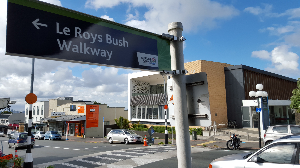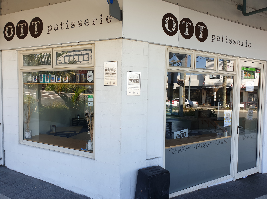Additional Information
1. Zion Hill Church - Named after Mt Zion by a visiting Presbyterian Minister. First church, 1880
- In 1880, the first church was built on the corner of Onewa Road and Birkenhead Avenue (known as Zion Hill). This church was designed by W.F. Hammond, an early architect and surveyor who had a large influence on the development of the area. The land used for the
Zion Hill Methodist church was donated by pioneer settler Mr Creamer. Prior to the opening of this church, settlers had either met in their homes or had travelled to St John’s Anglican Church in Northcote Point.
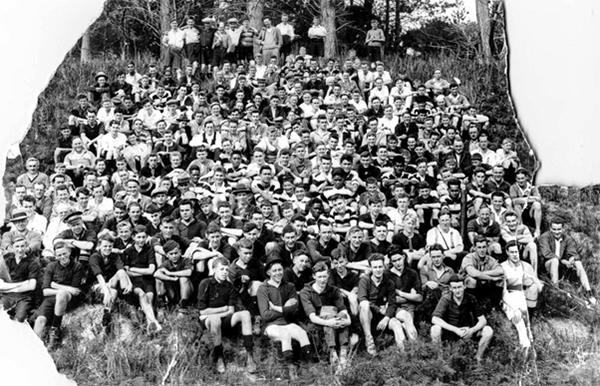
Caption: Zion Hill Easter Camp
With the opening of the Chelsea Sugar Works in 1884 came more workers, houses and settlers. As the only Sugar Factory in New Zealand, many workers migrated to the area over the early years of operation. As with most early settlements, the people of Birkenhead were largely Christian, most families attended church services and Sunday School every Sunday. With the influx of sugar workers, thus churchgoers, it was necessary to expand the church.
Designed by James Pickering in 1885, the current Gothic-style church was built in 1888. The Council meetings were held in the old church and were planned to coincide with the full moon as there were no street lights.
The original church still exists today as part of the church hall, which was built in 1902 and is still used frequently for Sunday School. As an amalgamation of differing architectural styles, the Zion Hill Methodist. The Sunday School was built in a day.
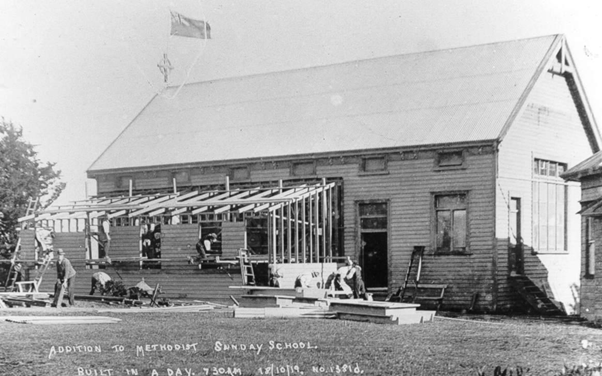
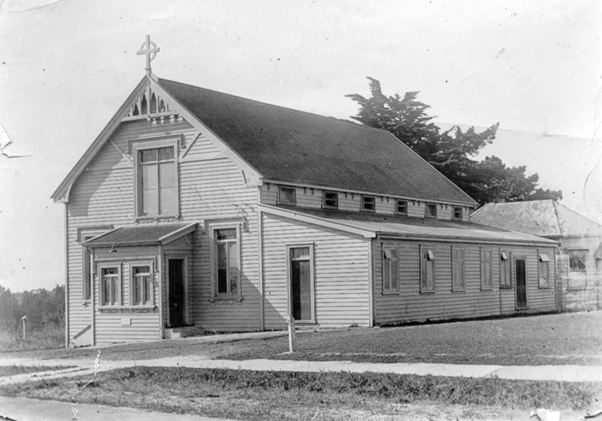
2. Hammond Place - Named after WF Hammond an early surveyor and developer.
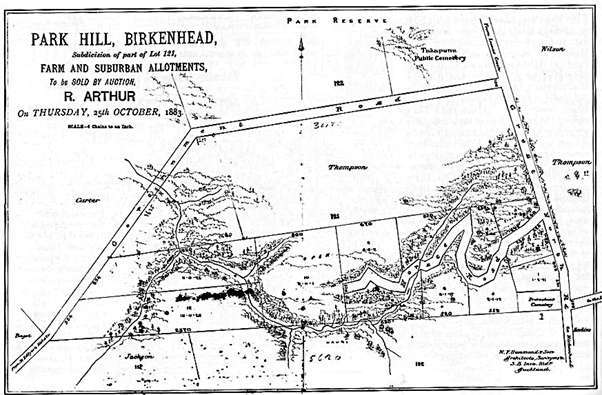
Local survey map by Will Hammond
- William Francis Hammond was an Auckland architect, surveyor and map maker. He migrated to Birkenhead from Ponsonby in 1897 after his first wife, Rebecca, died in 1877. He was left with nine children, so decided to make a fresh start. It has been said that Hammond was attracted to the area because of local girl Annabella Findlay Alston. She was the daughter of the Forghams (farmers at nearby Lucas Creek), who he had met previously while in the area on business. Hammond kept a diary of his courtship with Annabella, which was accompanied by pen and ink drawings. In 1879 Hammond and Annabella married and had five children of their own over several years.
As you would expect from a wealthy man like Hammond, he owned a thirty acre property called Raven Hill, on Hinemoa Street, near Rugby Road. Ravel Hill was a very substantial property; swooping driveways and well planned grounds can be seen in the subdivision plans, which date from 1889.
Hammond was, in part, responsible for the naming of Highbury. The area is named after the family home of William Francis Hammond, whose parent’s house in Highgate, London was named Highbury. Hammond’s wife’s parents, the Forghams, came to live near their
daughter, and their house on the ridge opposite the Zion Hill Church was called Highbury Cottage. From then on, the name spread to the area surrounding the house and in recent years has been adopted by the local shopping mall.
3. Hammond House - It is from Hammond that the name ‘Highbury’ started, as it was the name given to the house he built for the Forghams, as pictured c.1900.
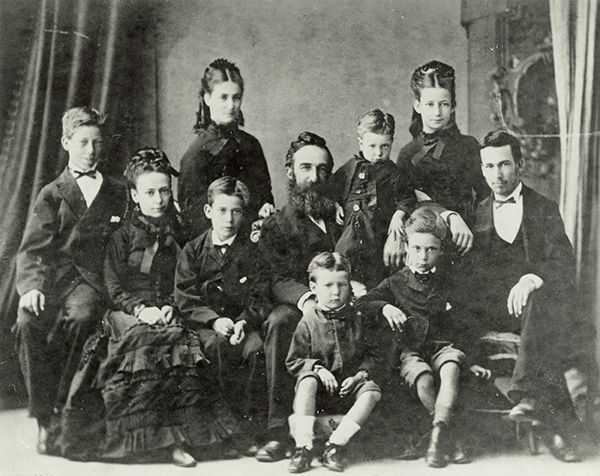
- William Francis Hammond was an Auckland architect, surveyor and map maker. He migrated to Birkenhead from Ponsonby in 1897 after his first wife, Rebecca, died in 1877. He was left with nine children, so decided to make a fresh start. It has been said that Hammond
was attracted to the area because of local girl Annabella Findlay Alston. She was the daughter of the Forghams (farmers at nearby Lucas Creek), who he had met previously while in the area on business. Hammond kept a diary of his courtship with Annabella, which was accompanied by pen and ink drawings. In 1879 Hammond and Annabella married and had five children of their own over several years.
As you would expect from a wealthy man like Hammond, he owned a thirty acre property called Raven Hill, on Hinemoa Street, near Rugby Road. Ravel Hill was a very substantial property; swooping driveways and well planned grounds can be seen in the subdivision plans, which date from 1889.
Hammond was, in part, responsible for the naming of Highbury. The area is named after the family home of William Francis Hammond, whose parent’s house in Highgate, London was named Highbury. Hammond’s wife’s parents, the Forghams, came to live near their
daughter, and their house on the ridge opposite the Zion Hill Church was called Highbury Cottage. From then on, the name spread to the area surrounding the house and in recent years has been adopted by the local shopping mall.
4. Payne's Building - Built for local business man W H Payne in 1927-8.
- At Highbury Corner stands the Oborn’s Buildings; originally known as Payne’s Building. The substantial two-level building was built in 1927-8 for local businessman W H Payne, who had been a member of the Borough Council in 1926-27. He was a land agent and is credited as
the person who saw the potential for development of the commercial hub at Highbury.
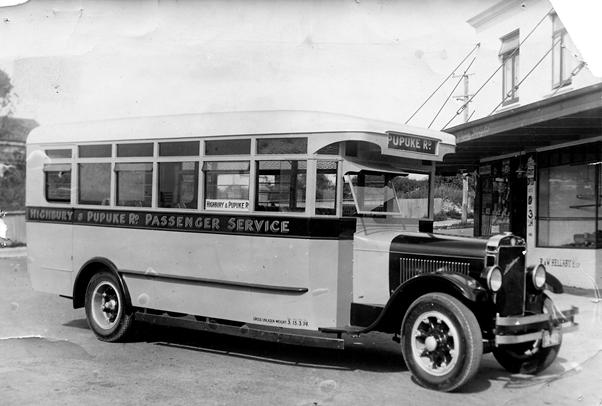
Bus outside Oborn Building
- The farm on which the Payne’s Building was to be erected at the Highbury Corner was originally owned by Annabelle Hammond, wife of local architect W.F Hammond. In 1895, the property was sold to William and Eliza Taylor, who subdivided it in 1911. In May 1917, William Henry Payne purchased Lot One of this subdivision.
An arcade and four single-storey shops were added to the building along the Mokoia Road frontage in 1963, around which time the complex became known as Oborn’s Buildings (possibly after a shoe shop proprietor of the same name who first appeared at Highbury c.
1955). The building is important in representing themes in the historic development of Birkenhead including commercial and public architecture and retail and commerce. It is in an elevated and prominent position, particularly when viewed looking up Hinemoa Street and has defined this main corner in the Highbury centre for 80 years.
5. Highbury Corner 1910 -
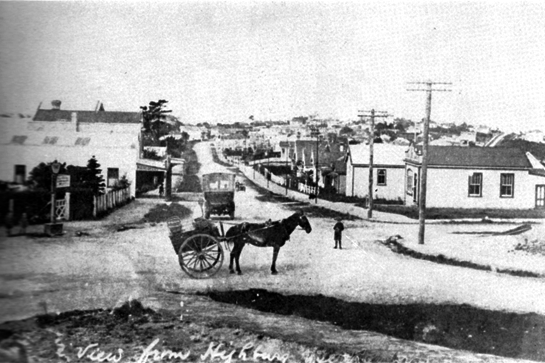
The photo shows the corner in c.1910.
6. Highbury Corner 1928 -
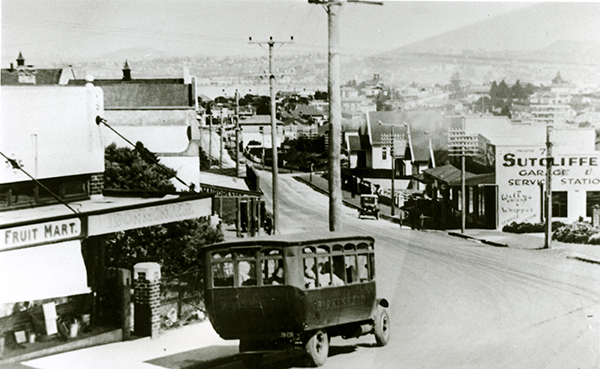
The photo shows a bus passing through the corner, c.1928.
7. Highbury Corner - The corner developed as the commercial heart of the village, with the shops and the buildings around the corner playing a very important part in the atmosphere and spirit of the village.
- In 1913, Highbury corner was nothing more than a stretch of fields with a few buildings around it. On the lower corner was the small Council Chambers (on land bought for £16), the Shepherd home on one corner, the Taylor’s farm on another and orchards all around. The roads on the corner were later sealed in the 1920s, which aided transport around the area. After this the corner developed as the heart of the village, with all the roads joining at this one corner. This was prior to the days of the
Highbury Bypass, so all traffic travelling past Birkenhead had to go through the village itself. An impression of a visitor to Highbury Corner in 1927 was published by the Birkenhead Business Association: “Higher up the hill many charming homes with their well set out grounds attract the eye and tempt one to break the tenth commandment. Oh, how one would be able to settle down in Birkenhead and have a house with an outlook over the Waitemata such as there is from here.
“Ha! This is Highbury Corner, is it? How different from what it was a few years ago. This evidently is going to be Birkenhead’s shopping centre – not the Post Office end as one would have judged a few years ago.” Much of the development of Highbury as a shopping centre has been credited to W.H Payne, a local man with a foresight that many people of the day perhaps lacked. On the corner of Rawene and Mokoia roads is the site where the Shepherd Homestead was located in the early 1900s. Henry Medland Shepherd was a wealthy landowner and Sharebroker of the time; he owned various pieces of land throughout Birkenhead. His grand home sat proudly on the corner, set back from the road with substantial grounds. After his death in 1927, the land was divided up and sold to buyers. A portion was also set aside for the future Post Office at 20-20A Mokoia Road. The site where the homestead was is now around where the Rawene Chambers are, and the gravel carpark next to them. Highbury Corner has served as the commercial heart of Birkenhead for 80 plus years. The shops in the buildings around the corner play a very important part in the atmosphere and spirit of the village. Today, the corner is still greatly important to the workings of the village.
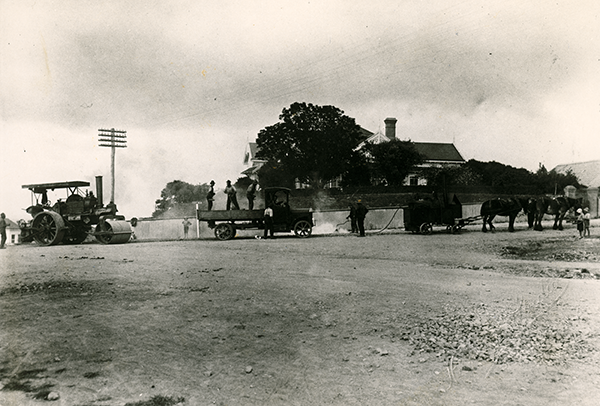
8. Highbury Buildings - The Highbury Buildings were built in 1934, with the current Yarnton family business setting up shop in 1949.
- The Highbury Buildings, at 14-20 Mokoia Road, were built in 1934. Although the architect is unkown, it is assumed that W.H. Payne was behind the development. The building is a simple 1930s retail building, with a suspended verandah and five bay ‘step-down’ facade.
The shop front is clad in Summerhill stone, possibly the result of modernisation in 1963. The site of the Highbury Buildings was once part of a large farm, mostly owned by William Francis Hammond in 1885. Title for this property was issued to Charles John Lindberg in
1899. The site was later owned by Henry Medland Shepherd, sharebroker. When he died in 1927, his property at 2-20 Mokoia Road was offered to the Birkenhead Borough Council as a
site for a Town Hall, but amid local opposition and failure to gain Government approval, the offer lapsed.
By 1939 the building was the location for stationer C. Neads; a branch of the Blue and White stores; the first Highbury branch of the Post Office (estd 1935); J.H. Clark, draper and W.G.Markham, upholsterer. By 1949, draper J.S. Yarnton took up business in part of the block.
Yarntons still occupy a large part of the building today.
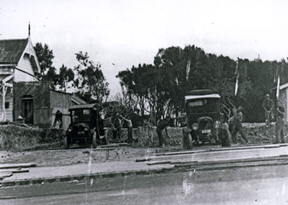
- During the early 1900s, numerous petitions were lodged, asking for a permanent school for Birkenhead residents. In 1913, some land on Roberts Road (now Mokoia Road) was purchased by the Education Road. Later, in 1914, a portion of Edward Skeate’s Highbury Estate was bought for the primary school. However, the school was not actually built until 1919, due to a lack of funds and the intervention of the First World War. Despite the rest of the original school having been replaced by new school buildings, the lychgate and fence still stand as a nod to the history of the school. This particular lychgate (also known as a lynchgate and lichgate) is a more modern interpretation of a British tradition. Originally, lichgates were erected at the entrance to churches and served as the location and shelter for the first part of a funeral ceremony, as the body was carried into the church grounds. Lychgates also have links to spiritual purposes, such as warding off evil spirits. However, this lychgate could also have been used a form of shelter for the parents of the children, as well the children themselves, at times of inclement weather.

10. Nell Fisher Reserve - The reserve now holds the name “Nell Fisher Reserve”, after the Council’s first paid librarian. The
heritage War Memorial has been refurbished and proudly sits in the reserve, serving as a reminder of those we lost in the war.
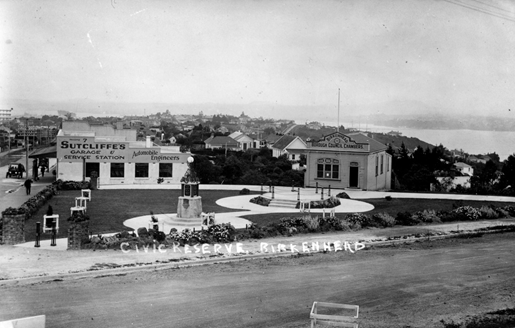
- The corner of Rawene Road and Hinemoa Street has an important association with the history of Birkenhead. It was on this corner that the first Birkenhead Borough Council Chambers were located. In front of the council chambers was a small civic reserve, as designed by the Borough Engineer Mr Frank Finch. Adjacent to the Borough Council Chambers was the Sutcliffe’s Garage and Service Station, the first ‘Automobile Engineers’ in the area.
Finch also later designed the War Memorial monument that is sited in the reserve. This memorial was crafted in 1927 in a beautiful art deco style. From ‘Back Then... Volume Four’ by Colleen Christie:
“The base consists of two tiers of steps in concrete, octagonal in shape... upon which is built a massive block of rough-key grey granite, indicating strength. Four Polished red granite columns...fittingly represent the virtues of Duty, Service, Fidelity, and Justice. Empanelled on each side, and between the columns, are four polished black slabs bearing inscriptions. Surmounting these is a beautiful floral standard in bronze embodying the olive leaf and branch, and the victor’s wreath. The standard supports an opal globe enclosing an electric light which burns every evening from sunset to midnight.”
In the 1960s the first true Birkenhead Library was built. Previously, books were held at the Zion hill Methodist Church, as well as in the basement of the Council Building. The new library was a very
modern design for the 1960s and was built by the O’Sullivan brothers. The library was officially opened by the Governor-General, Sir Arthur Porritt on 20 April, 1968. When it opened, it had £500 worth of books on its shelves, thanks to forward-thinking councillor Nora Bourke. Today, the newly designed and built Birkenhead Library sits on the site, behind the redeveloped civic reserve.
11. St Andrews Church - Built in 1914, the first service was held in the Birkenhead Presbyterian Church on 13 th December.
- After a visit to the Birkenhead area by Rev. Isaac Jolly in July 1911, he expressed the hope that “at no distant date a new church will be erected at Birkenhead to meet the needs of that growing district”.
Earlier, in February 1908, Mr E Clark reported to a meeting of the Northcote Board of Management that a section had been selected at Birkenhead and moved that it be secured for a church site, at a
cost of £100. The site for the Birkenhead Church in Crescent Road (now 28 Mariposa Crescent) was transferred to the Presbyterian Church of New Zealand on 6 November 1909 at 12 noon. A report in the NZ Herald on 17 November 1914 says that “On Saturday 14 November the foundation stone was laid by Mr J.W. Stewart Esq., in the presence of a large gathering”. The church being built was to be of wooden construction, measured at 45 feet long and 25 feet wide, the
seating capacity of 200 adults. The first service in the church was held on the 13 th of December 1914.
In August 1928, a new site for the church became available through S. Vaile and Sons, for £400. The decision was made to shift the church to the site instead of retaining it for a future manse. On December 9 the first services in the relocated building were held. This is the site where the church stands today, at 172 Hinemoa Street, Birkenhead.
After being put to vote in 1932, the church was named after Saint Andrew, the Patron Saint of Scotland. St Andrew’s Presbyterian Church is still highly active today, as the meeting place for the Presbyterian section of the Birkenhead community.
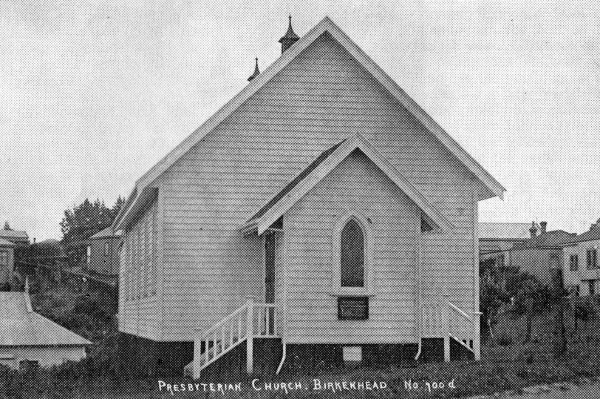
12. All Saints Church - 1910, originally Foresters Hall, note forest imagery on stained glass windows and original kauri wood.
- In 1908, Anglican Church services took place in the original Foresters Lodge Hall. Situated in Hauraki Street (now Hinemoa Street) in Highbury, it was a building constructed from native Kauri. Services continued there until a meeting on 1 September 1910, resolved "That the time had arrived when the Church of England should take the steps forward of purchasing a suitable site for the subsequent erection of a Church. On 1 January 1911, the Foresters Lodge Hall was purchased by the Church at a cost of £325. It was said that the hall would soon have to be transformed into a Church and extra seating provided. In the early part of 1913, All Saints Church underwent extensive enlargements and the addition of a schoolroom. On Friday 20 June 1913, All Saints Church was re-opened for dedication by the Bishop Commissary Archdeacon Calder. Services continued in the Church on the Highbury site until 1923, when the building was moved further down the Street to its present site at 187 Hinemoa Street. The building had to be first split into two sections - the upper floor (the main Church room) being removed from the Sunday School rooms underneath. Subsequently, the Sunday School room portion was re-assembled across the rear of the new site, so as the form the Parish Hall (today known as the Foresters Hall). The Church itself was repositioned in front; closer to the road. Due to having been built from the dissected hall, the stained glass windows in the church are not of a religious type. They depict an oak leaf, which relates to Sherwood Forest in England, hence the name of the original hall. These can still be seen in the church today.
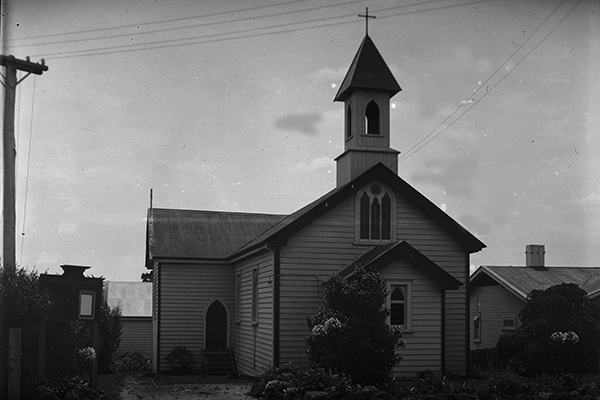
13. Highbury Cash Store - was the first general store near Highbury.
- The S. Roberts ‘General Provider’ was the first general store near Highbury. Despite an S. Roberts general store having been built near the wharf in 1904, it was deemed necessary to have another store closer to the growing shopping centre of Birkenhead. This store was established in 1913 and was situated near the top of Hauraki Street (now Hinemoa Street). Items sold included butter stamped with an acorn, made by Agnes Harkin in Hutton Road. There was also another S. Roberts store half way up Hinemoa Street during the early days of Birkenhead. The building itself was one of the two first commercial buildings in the Highbury centre, along with the Hawkins grocer next door. As a substantial double-level building, it stood proud of its rather
sparse surroundings. The upright facade on the top of the building bore the name ‘Highbury Cash Store’, which can be seen as a reference to the anticipation of a large potential market within Highbury. Soon after, the commercial development of Highbury boomed, with entire blocks of shops being erected to house businesses. While the village grew around it, the store remained an important part of the heart of Highbury.
The store is now operating as the Mulan Malaysian Restaurant and remains largely unchanged from its original layout.
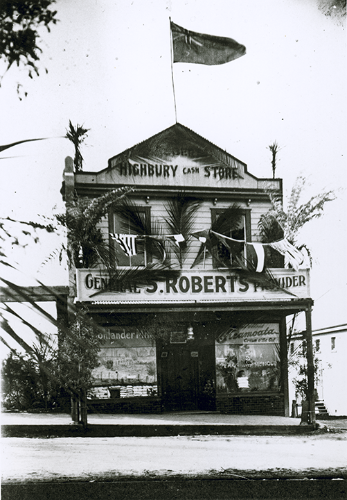
14. Hawkins Store - Oldest and original commercial building built circa 1910. 243 Hinemoa St.
- Henry Hawkins surprised everybody with his fruit-growing success near Highbury. Despite growing in tough clay soil that was considered unsuitable for fruit trees, Hawkins’ management and growing techniques produced trees full of apples, pears, medlars, peaches, nectarines, apricots, plums and cherries.
When his Belvedere Nursery was well established, he bought more land in Soldier’s Bay and proved everyone wrong by planting his trees at shallow depths, on steep southerly slopes. The clay soil was even heavier here than in Highbury, yet the trees still thrived. His desire to
find things out for himself, over listening to others, made his success what it was. This attitude is what caused him to be respected as one of the top nurserymen in Auckland. Hawkins himself was born on September 5 1808 in Bath, England. He lived a very respectable 94 years until he died in Birkenhead on August 13 1902. The Hawkins grocery store, at 245 Hinemoa Street, was built in 1920. Adjacent to the double-level S. Roberts General Providers, it was built as a single level building with an upright facade, in a very early simple art deco style. It has a plain parapet with curved pediment and cornice, with the verandah originally being supported by wooden posts, with an upright fascia for signage. The building is one of the two earliest commercial buildings in the Highbury centre, along with the general store next door.
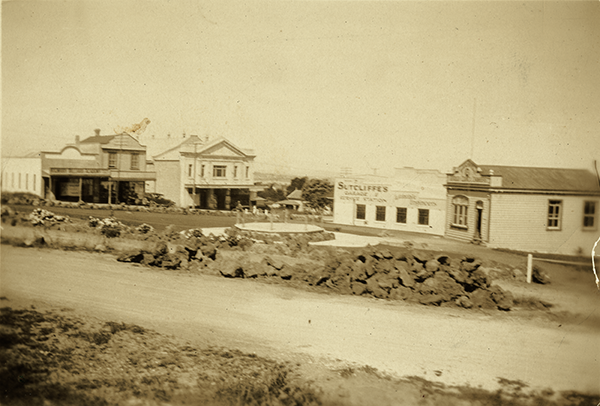
15. Frederick Morris Block - the first block of shops to be erected at Highbury Corner.
- The Frederick Morris Block, at 1-15 Birkenhead Ave, is the first block of shops to be erected at Highbury Corner. Having been built by F. Morris in 1923 as a block of eight single level shops, they wrap around the corner of Birkenhead Ave and Hinemoa Street. The buildings have a simple plastered masonry facade with unornamented parapets. Plain pilasters divide each of the eight shops.
The plain, repeated parapets and verandahs of the building help define Highbury Corner. The building contributes to an understanding of the development of the commercial centre in the 1920s-30s. Originally, the building housed numerous small businesses, including a grocers, a cake shop, a hardware shop, a fruit shop and a habadashery shop. In more recent years, a two storied shop/office has replaced two of the original shops in the centre of the block. However, one of the original brick pillars can be seen on the road side of the southern wall of the building.
Frederick Morris was a builder who migrated to New Zealand in 1908. He initially lived in Mt Roskill, next moving to Mt Eden. He served on the Mt Eden Borough Council for seven years, before moving to Birkenhead in 1929. He served on the Birkenhead Borough Council from 1930 until his death in 1934.
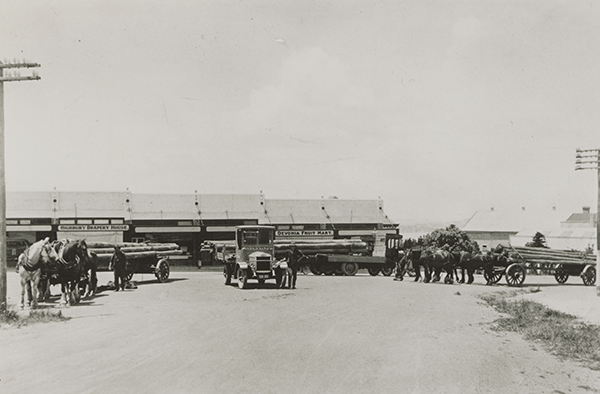 |

